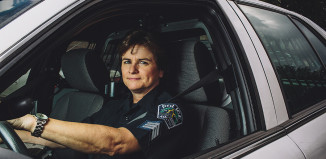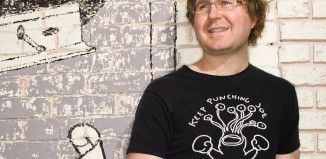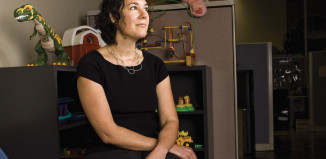I haven’t been a runner for a long time, but I’ve done a few races. Half marathons and one full marathon. Even a little triathlon. The finish lines are all pretty much the same. Anonymity is what you find at most of them. A fenced cattle chute lined with strangers and if it’s really fancy a hidden announcer with a microphone mispronouncing my name. I usually find someone to take a photo of me with my medal — pretending I’m not winded — then stumble up to the table of half-bananas, quarter-oranges and the volunteer on the other side wearing latex gloves and a look on her face that says, “Eww. When is my shift over?”
Well, now here I am head of the Hill Country Ride for AIDS, and it’s my job to put on a bike ride. And that includes a finish line.
The HCRA has been around 16 years, so there’s a general template of how most of it goes. One of the greatest things started by the founder is greeting every cyclist with a hug and their medal. A smile, a high-five, and a sincere congratulatory welcome. It’s kinda the coolest thing, and I’m super-lucky to be the one who gets to do it.
Instead of metal guardrails we have long red flags flowing atop tall bamboo poles. Instead of strangers waiting for their loved one we have cheerleaders waving pompoms and dressed in anything from unicorn outfits to rainbow colored tutus. Granted most are just wearing tshirts, but still the atmosphere is pretty festive. There’s always loud dance music, and oftentimes riders will hang out at the finish line to welcome everyone home.
But the cool thing for me is the hug. See, there are about 500 riders who sign up, train, and raise money — the fundraising gets distributed to 10 local AIDS services agencies in and around Austin — for months before the day of the ride. They’ve invested time, energy, and emotion into this. We have riders of all levels. Some ride once a year while others may be world-class athletes. But they all have one thing in common: passion for this cause. And I get to see this passion propel them on a journey that lands them right in my arms.
Whether they rode 13 miles or almost 100, they all accomplished something. In the name of the lover who died 30 years ago, the son they lost to AIDS three years ago, or their friend who was just diagnosed 3 months ago they all are working towards honoring others. They all want to say they did something difficult to restore faith and maintain the memory of the struggles of others. In the early years death from AIDS was ugly. It was hell. It came with layers of stigma, uncertainty, pain, and horror. It still can. And although most in our community are able to live with an HIV diagnosis without all of this, it’s not guaranteed.
The ride gives people a chance to say, “let me do this to help you.” It gives them an opportunity to make a difference.
So they set out training months in advance. They send out emails and make posts asking for money. And one day they line up on a little country road with hundreds of other riders and set out to ride the tangible, difficult, sweaty miles that represents their commitment to the struggle of someone else.
And I wait for them. With the dance music, gleeful kids with pompoms, and long red flags against a perfect blue sky I wait.
One by one they turn off that little country road onto a little dirt path that leads them straight to the cheers, the music, and my welcoming arms. Before they know it, they’re done. They’ve been pedaling for hours, some for many hours. And although we have fun party-like pitstops, decorated SAG support vehicles, and sexy support volunteers all along the route, they’ve worked their buns off to finish.
It may be the first time they’ve stopped since the last pitstop, so it sort of catches them off guard. They’re done. They did it.
They find themselves being held by me, and oftentimes it hits them hard. They’re done. It’s over.
Their lover really did die. Their son really is dead and gone. This stupid disease really does still affect people all around us.
And I really am holding them.
I feel it all rush in, and I do my best to help carry the weight of it. I take on some of their grief and their joy and give them back gratitude from all the recipients who will benefit from everything the riders have done for them. I try to make them feel the love. I want them to know what they’ve done matters. That who they are matters.
We all want to be seen. We all want to make a difference. And the coolest thing in the world is to give people this reality surrounded by cheering teenagers, fun dance music, and long, flowing red flags under a perfect blue sky.



































